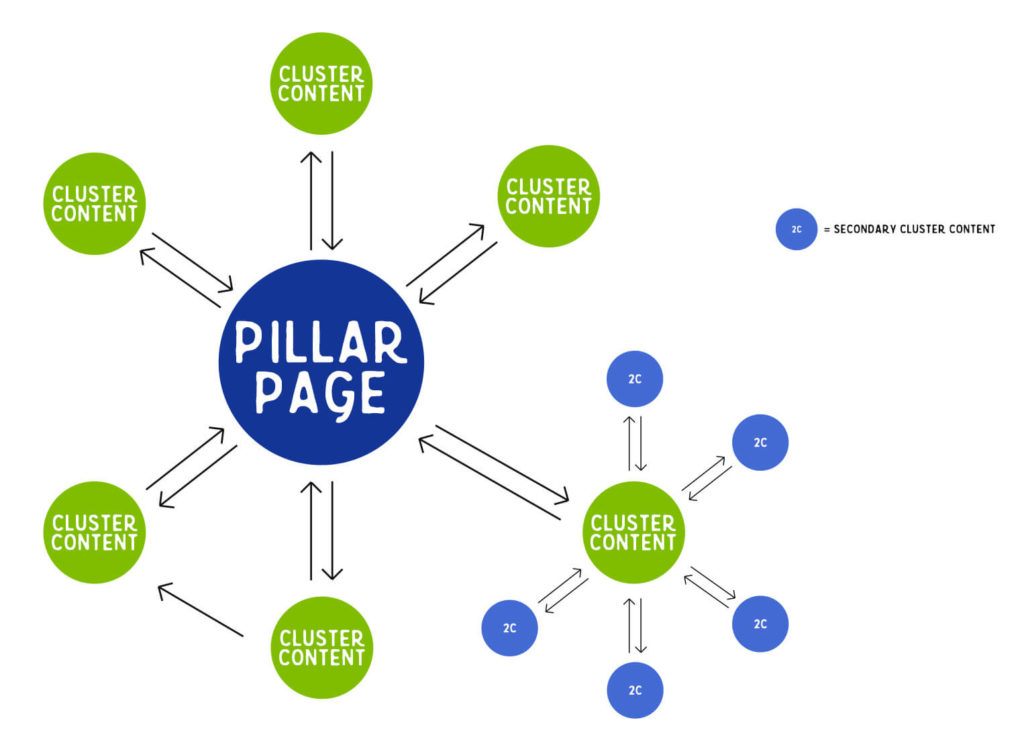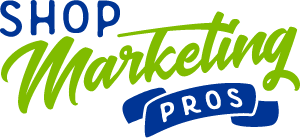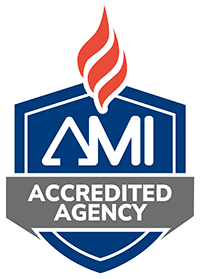Throughout the years, SEO has changed. But the one thing that has remained consistent is that having a website full of high-quality content can lead to very good rankings, which is one of the most important things you can work towards in your auto repair shop’s marketing.
Content alone isn’t always enough, but all other things being equal, the website with the best, and most content will win.
This article is going to talk about one of the many different ways of structuring content on your auto repair shop’s website, and that is the Pillar Page and Topic Cluster model.
Before getting into this model, let’s talk about two of the other models that are out there. I want to talk briefly about each because using the ideas from each of these models in your pillar pages will amplify the effects of pillar page and topic clusters.
Skyscraper Content
Conceived by Brian Dean of Backlinko, the idea behind skyscraper content is to find the page that ranks in the number 1 spot for the term you want to rank for, then go build a page that is better than it.
Have you ever walked by a really tall building and said to yourself: “Wow, that’s amazing! I wonder how big the 8th tallest building in the world is.” Of course not. It’s human nature to be attracted to the best.
– Brian Dean, Backlinko
Your page’s content should be higher quality, better researched, more up-to-date, and a better overall resource to the reader than the page you are trying to outrank. Once you have created your content, you reach out to the people who are linking to the page you are trying to outrank, tell them about your content, and ask them to link to you, instead of – or in addition to, the other page.
“It’s like finding the tallest “skyscraper” in your space…and slapping 20 stories to the top of it.”
– Brian Dean, Backlinko
Here is Brian’s guide to skyscraper content.
10x Content
Conceived by Rand Fishkin of MOZ, 10x content is vaguely similar to skyscraper content. The idea is to create content that is not only better, but that is 10 times better than anything else for what you want to rank for.
“When your competitors or other folks in the field look and say, “Hey, there’s no way that we can scale content quality like this. It’s just too much effort. We can’t keep producing it at this level,” well, now you have a competitive advantage.”
– Rand Fishkin, Co-Founder & CEO – MOZ
10x content focuses on “search intent” rather than just ranking for certain keywords. Rand also recommends creating an amazing user experience for the reader. It’s not just about the words being 10 times better, but the entire experience of consuming what you’ve created being 10 times better.
Most of the time when someone is thinking about content like what we’re talking about, they think of single pages, articles, or posts. 10x content is different in that it can be multiple pages, posts, articles, or even an entire website. It’s more about all of your content as a whole rather than a single piece of content.
After you’ve finished reading this, go watch Rand’s Whiteboard Friday video where he explains 10x content.
Pillar Page and Topic Cluster model
In 2017, Hubspot conceived the idea of pillar pages and topic clusters. This is the content model we love and recommend for auto repair shops that are in more competitive geographic areas.
Here is their article explaining what a pillar page is.
In this model, we are optimizing a website for a topic rather than certain keywords or phrases. We are building so much high-quality content that focuses on a topic that Google will award you with top-level rankings for nearly anything that is searched for around your topic of choice.
The basic idea here is to build an in-depth page or pages (pillar page/s) about a certain topic, that is supported by smaller pages (cluster topics) that go deeper about what you’ve talked about in the pillar page.


Your pillar pages are usually going to be much longer than any of your other content. For example, my pillar page, “The Ultimate Guide to Auto Repair Shop Marketing” is nearly 17,000 words as of this writing, and it continues to grow.
Your topic cluster pages are typically normal to medium length content. Most of my topic cluster pages are around 1000 words, but some are only a few hundred words while others are 2500 words. Your topic cluster pages can actually become small pillar pages in themselves, with their own topic clusters.
It is common that you will have multiple levels of topic clusters. Below are some example outlines of how an auto repair shop might use pillar pages and topic clusters.
Example 1
Auto Repair Services (pillar page)
- Tires and Alignments (topic cluster)
- Vehicle Maintenance (topic cluster)
- Diesel Truck Repairs (topic cluster)
- Check Engine Light Diagnosis (topic cluster)
- Transmission Repairs (topic cluster)
-or-
Example 2
Auto Repair Services (pillar page)
- Tires and Alignments (topic cluster)
- Road Force Balancing (secondary topic cluster)
- 4 Wheel Alignments (secondary topic cluster)
- Snow Tires (secondary topic cluster)
- Off-Road Tires (secondary topic cluster)
- Aftermarket Wheels (secondary topic cluster)
- Large Wheel Specialists (secondary topic cluster)
- Vehicle Maintenance (topic cluster)
- Oil and Filter Changes (secondary topic cluster)
- Timing Belt Replacement (secondary topic cluster)
- 30k, 60k, 90k Services (secondary topic cluster)
- Vehicle Winterization Services (secondary topic cluster)
- State Inspections (secondary topic cluster)
- Diesel Truck Repairs (topic cluster)
- Ford Powerstroke Repairs (secondary topic cluster)
- Powerstroke Injector Replacement (third-level topic cluster)
- GM Duramax Repairs (secondary topic cluster)
- Allison Transmission Repairs and Maintenance (third-level topic cluster)
- Duramax Valve Cover Gasket Replacement (third-level topic cluster)
- Dodge RAM Cummins Repairs (secondary topic cluster)
- Killer Dowel Pin Fix (third-level topic cluster)
- Ford Powerstroke Repairs (secondary topic cluster)
- Check Engine Light Diagnosis (topic cluster)
- Transmission Repairs (topic cluster)
In situations where you’re in a very competitive geographic area, like Atlanta or Houston, you may have your content organized with multiple pillar pages. That may look like this:
Example 3
Diesel Truck Repairs (pillar page)
- Ford Powerstroke Repairs (topic cluster)
- Powerstroke Injector Replacement (secondary topic cluster)
- GM Duramax Repairs (topic cluster)
- Allison Transmission Repairs and Maintenance (secondary topic cluster)
- Duramax Valve Cover Gasket Replacement (secondary topic cluster)
- Dodge RAM Cummins Repairs (topic cluster)
- Killer Dowel Pin Fix (secondary topic cluster)
European Car Services (pillar page)
- Mercedes Service and Repair (topic cluster)
- A and B Services (secondary topic cluster)
- Bluetec Diesel Repair (secondary topic cluster)
- BMW Service and Repair (topic cluster)
- iDrive Specialists (secondary topic cluster)
- BMW Oil Leak Repairs (secondary topic cluster)
- VW / Audi Service and Repair (topic cluster)
- VW / Audi Timing Belt Replacement (secondary topic cluster)
- VW / Audi Coolant Leaks (secondary topic cluster)
Tires and Alignments (pillar page)
- Road Force Balancing (topic cluster)
- 4 Wheel Alignments (topic cluster)
- Snow Tires (topic cluster)
- Off-Road Tires (topic cluster)
- Balancing Large Off-Road Tires (secondary topic cluster)
- Mounting Large Off-Road Tires (secondary topic cluster)
Remember, the difference between example 2 and example 3 are that each main topic is a pillar page, which means it’s going to be very long pages of content, 5000 words or more in most cases.
Your pillar page will link out to your various topic cluster articles and the topic clusters will link back to the pillar page, and to other topic cluster articles.
The thing I love most about this model is how easy it makes it to come up with new topics. As you are writing your pillar page, you will think of topic after topic for cluster articles.
In example 3 above, you can see where the ideas for creating content for your auto repair shop marketing could be endless. Let’s say you create a pillar page for European car service and repair. Now you can write cluster articles for all of the common repairs for every make and model of European vehicle that you service. Examples might include:
- Mercedes M104 head gasket replacement
- BMW M54 rough running
- VW Passat coolant leaks
And the list can go on, and on, and on.
Your content doesn’t have to be written content only. Here are some ideas for creating content quickly.
- Shoot videos of yourself and your technicians talking about common problems and the fix. Upload the videos to your YouTube channel, then have them transcribed by a service like Temi. Embed the video and place the transcribed content into a blog post or article.
- Record audio in a podcast like format. Have it transcribed, just like the video, and place the audio and transcription into a blog post or article.
- Take pictures throughout the process of a repair. Post those pictures into a photo gallery and put descriptions for each image.
When creating your pillar pages and topic cluster articles, take inspiration from skyscraper content and 10x content. Find the websites, articles, and posts that rank the best for your topic and go create content that’s 10 times better. Design the best user experience possible. Finally, do outreach to the people who are linking to those content pieces and get them to link to your content.
If you do these things, you’ll be sure to outrank your competition and see new customers that you never would have otherwise.

About The Author



